How To Calculate The Inductance Of PCB Trace
A printed circuit board, or PCB, serves as the operating guts of computers and other electronic equipment. It consists of a network of integrated circuits interconnected by PCB traces. PCB traces are small conductor strips on the PCB that enable current flow to and from integrated circuits. As with standard cable, wires and conductors, PCB traces have measurable impedance, capacitance and inductance levels associated with it. Engineers have to take these values into account in designing PCB-based electrical equipment.
Step 1
Find the PCB trace impedance, or "Zo." Refer to the design requirements or schematics of the PCB. As an example, Zo is 20 millohms.
Step 2
Find the trace delay, or "DLY," in pico seconds or "ps" per inch. A picosecond is 1 x 10^-12 seconds. DLY is a standard parameter associated with PCBs. Refer to PCB design requirements or schematics. As an example, assume DLY is 12 ps.
Step 3
Calculate the PCB trace inductance, or "L," using the formula L = Zo * DLY. Using the example numbers:
L = 20 x 10^-3 * 12 x 10^-12 = 240 x 10^-15 henries or 0.24 pH, where pH is units of picohenries. Traces on PCBs are small and therefore have small inductance levels.
Cite This Article
MLA
Chestnut, Dwight. "How To Calculate The Inductance Of PCB Trace" sciencing.com, https://www.sciencing.com/how-8711937-calculate-inductance-pcb-trace/. 7 August 2017.
APA
Chestnut, Dwight. (2017, August 7). How To Calculate The Inductance Of PCB Trace. sciencing.com. Retrieved from https://www.sciencing.com/how-8711937-calculate-inductance-pcb-trace/
Chicago
Chestnut, Dwight. How To Calculate The Inductance Of PCB Trace last modified March 24, 2022. https://www.sciencing.com/how-8711937-calculate-inductance-pcb-trace/
